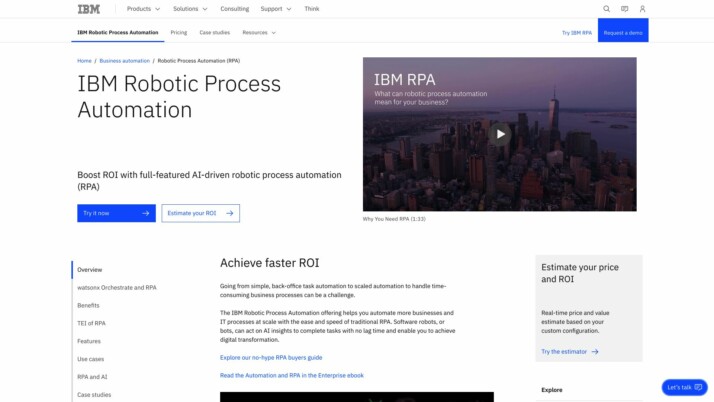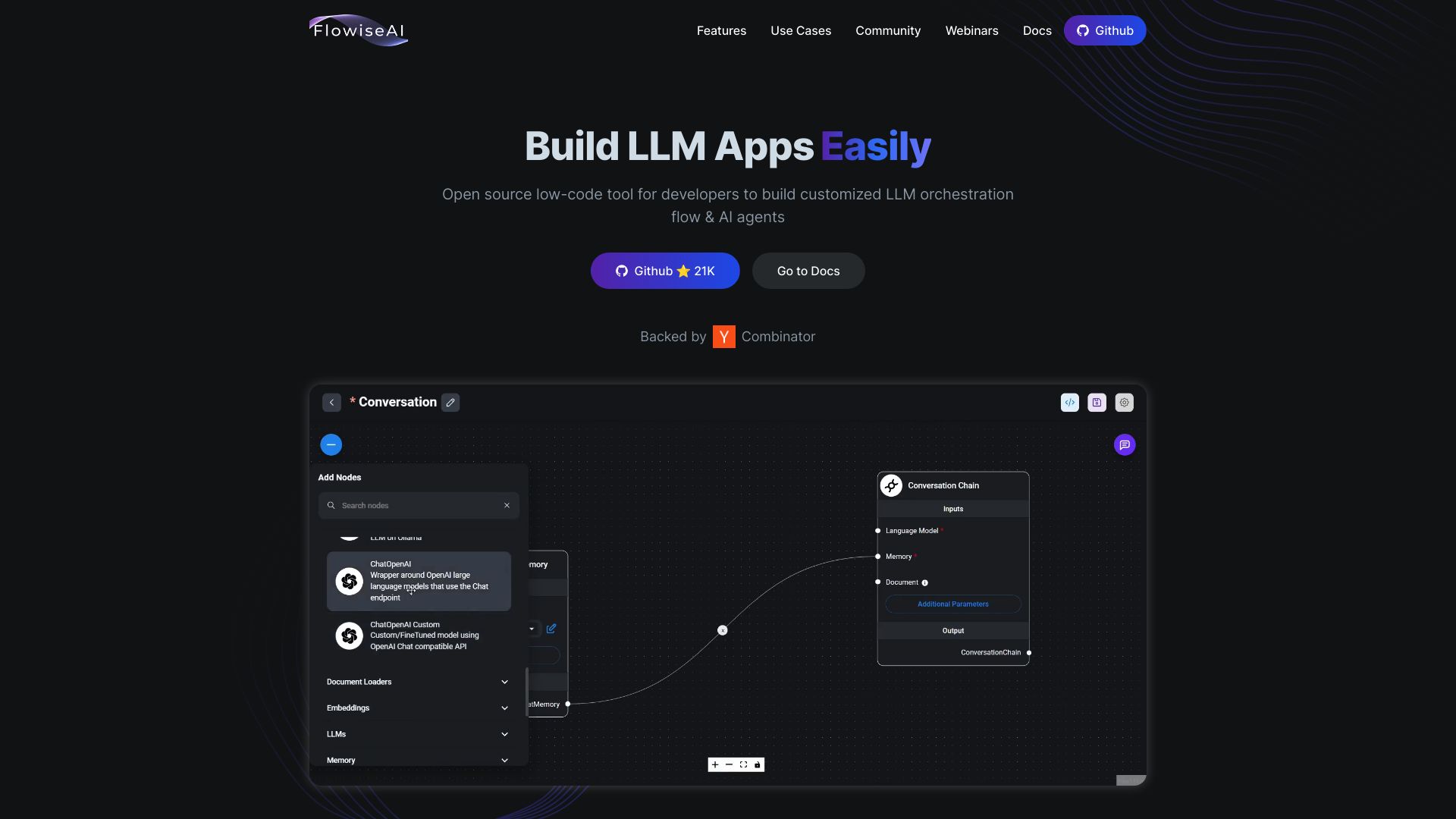IBM RPA vs. FlowiseAI: Enterprise Automation or LLM Orchestration?
AI-powered automation reshapes business landscapes, driving efficiency and innovation across industries. As organizations seek powerful yet accessible solutions, the choice between enterprise-grade platforms and flexible open-source tools becomes crucial. This comparison explores IBM RPA’s robust automation capabilities, FlowiseAI’s innovative LLM orchestration, and SmythOS’s comprehensive AI development ecosystem.
We’ll examine how each platform addresses key challenges in AI implementation, from scalability and security to customization and ease of use. By analyzing their strengths, limitations, and unique features, we aim to guide technical teams, business leaders, and AI enthusiasts in selecting the ideal solution for their automation and AI development needs.
IBM RPA Overview
IBM RPA transforms business processes through intelligent automation. This powerful platform enables organizations to create, deploy, and manage software robots that mimic human actions across digital systems. IBM RPA streamlines repetitive tasks, enhances productivity, and reduces errors in various industries.


IBM RPA transforms business processes through intelligent automation… enables organizations to create, deploy, and manage software robots that mimic human actions across digital systems.
IBM RPA combines low-code tools with AI capabilities to empower both technical and non-technical users. The visual builder allows rapid bot creation through drag-and-drop interfaces, while AI integration enables bots to handle complex decision-making. This versatility makes IBM RPA suitable for automating tasks in finance, customer service, human resources, and more.
Key features of IBM RPA include unattended and attended bots, AI-powered decision-making, and seamless integration with existing enterprise systems. Unattended bots work autonomously on scheduled tasks, while attended bots assist human workers in real-time. The platform’s AI capabilities, powered by IBM watsonx, enable bots to understand context, extract information from unstructured data, and make intelligent decisions.
Key features of IBM RPA include unattended and attended bots, AI-powered decision-making, and seamless integration with existing enterprise systems.
IBM RPA excels in enterprise-grade security and scalability. The platform offers robust encryption, access controls, and audit logging to protect sensitive data and ensure compliance. Its cloud-native architecture allows organizations to scale their automation initiatives easily, deploying bots across multiple environments and geographies.
While IBM RPA provides comprehensive automation capabilities, its enterprise focus may present a steeper learning curve for smaller organizations or individual users. The platform’s extensive features and integrations can require significant time investment to fully leverage. However, for large enterprises seeking a powerful, scalable automation solution, IBM RPA delivers robust functionality and AI-driven innovation.
FlowiseAI Overview
FlowiseAI empowers developers to create custom large language model (LLM) orchestration flows and AI agents through an open-source, low-code platform. This innovative tool streamlines the development of LLM-based applications, offering an intuitive visual interface for crafting complex AI workflows.


Flowise’s drag-and-drop functionality accelerates prototyping and deployment, enabling developers to build sophisticated LLM applications without deep AI expertise. The platform supports integration with various document loaders, vector databases like Pinecone, and diverse data types including PDFs, web pages, and CSV files. This versatility makes FlowiseAI suitable for a wide range of use cases, from document analysis to customer support.
FlowiseAI empowers developers to create custom large language model (LLM) orchestration flows and AI agents through an open-source, low-code platform.
At the core of FlowiseAI lies its agent and chain system. Developers link various nodes such as document loaders, text splitters, and LLMs to create intricate workflows. This modular approach simplifies the creation and management of AI processes. The platform ships with pre-built templates and tools, including document loaders for different file types, text splitters for chunking documents, vector database connectors, and conversational retriever QA chains for question answering.
FlowiseAI’s vision centers on democratizing AI development by making it accessible to a broader audience. By offering an open-source, low-code platform, FlowiseAI aims to lower the barrier to entry for AI development, enabling more individuals and organizations to harness the power of large language models. This approach positions FlowiseAI as a valuable tool for industries seeking to implement AI solutions efficiently and cost-effectively.
Feature Comparison
IBM RPA and FlowiseAI showcase distinct approaches to automation and AI development, with notable gaps in their feature sets. IBM RPA excels in enterprise-grade automation with robust security features and scalability. Its strengths lie in unattended and attended bot capabilities, AI-powered decision-making through watsonx integration, and seamless enterprise system integration. IBM RPA offers comprehensive audit logging, governance tools, and supports concurrent bot execution for team-based work.
FlowiseAI, as an open-source low-code platform, focuses on LLM orchestration and AI agent development. It provides a visual interface for crafting AI workflows, supporting integration with various document loaders and vector databases. FlowiseAI’s modular approach allows for creating complex AI processes through its agent and chain system. However, it lacks some enterprise-focused features present in IBM RPA, such as extensive security controls and scalability options.
The core components and security features highlight significant differences. IBM RPA provides robust encryption, access controls, and integrates with IBM OpenPages for governance. FlowiseAI, while offering customization and integration capabilities, doesn’t match IBM RPA’s enterprise-grade security measures. IBM RPA’s scalable infrastructure and concurrent bot execution surpass FlowiseAI’s capabilities in handling large-scale deployments.
Feature Comparison Table
| IBM RPA | FlowiseAI | SmythOS | |
|---|---|---|---|
| CORE FEATURES | |||
| AI Agents | ❌ | ✅ | ✅ |
| Hosted Agents (Dev, Production) | ✅ | ❌ | ✅ |
| Environments (Dev, Production) | ✅ | ❌ | ✅ |
| Memory & Context | ❌ | ✅ | ✅ |
| Autonomous Agents | ❌ | ✅ | ✅ |
| Explainability & Transparency | ❌ | ✅ | ✅ |
| Debug Tools | ✅ | ❌ | ✅ |
| Multimodal | ❌ | ✅ | ✅ |
| Problem-Solving Capabilities | ❌ | ✅ | ✅ |
| Multi-Agent Collaboration | ❌ | ❌ | ✅ |
| Audit Logs for Analytics | ✅ | ❌ | ✅ |
| Work as Team | ❌ | ❌ | ✅ |
| SECURITY | |||
| Constrained Alignment | ❌ | ❌ | ✅ |
| OAuth | ❌ | ❌ | ✅ |
| IP Control | ❌ | ❌ | ✅ |
| COMPONENTS | |||
| Foundation AIs | ❌ | ✅ | ✅ |
| Huggingface AIs | ❌ | ✅ | ✅ |
| Zapier APIs | ❌ | ❌ | ✅ |
| Classifiers | ❌ | ❌ | ✅ |
| Data Lakes | ❌ | ❌ | ✅ |
| DEPLOYMENT OPTIONS (EMBODIMENTS) | |||
| Deploy as Webhook | ❌ | ✅ | ✅ |
| Staging Domains | ❌ | ❌ | ✅ |
| Production Domains | ❌ | ❌ | ✅ |
| API Authentication (OAuth + Key) | ❌ | ✅ | ✅ |
| Deploy as Site Chat | ❌ | ✅ | ✅ |
| Deploy as Scheduled Agent | ✅ | ❌ | ✅ |
| Deploy as GPT | ❌ | ✅ | ✅ |
| DATA LAKE SUPPORT | |||
| Hosted Vector Database | ❌ | ❌ | ✅ |
| Sitemap Crawler | ❌ | ❌ | ✅ |
| YouTube Transcript Crawler | ❌ | ❌ | ✅ |
| URL Crawler | ❌ | ✅ | ✅ |
| Word File Support | ✅ | ❌ | ✅ |
Best Alternative to IBM RPA and FlowiseAI
SmythOS stands out as the superior alternative to IBM RPA and FlowiseAI, offering a comprehensive platform for AI agent development and deployment. We’ve designed SmythOS to address the limitations of traditional automation tools and open-source AI platforms, providing a powerful yet user-friendly solution for businesses of all sizes.
Our drag-and-drop interface simplifies the process of creating complex AI workflows, making advanced AI functionalities accessible to users with varying levels of technical expertise. Unlike IBM RPA’s focus on robotic process automation or FlowiseAI’s emphasis on LLM orchestration, SmythOS delivers a versatile ecosystem for building, deploying, and managing AI agents across multiple use cases.
SmythOS delivers a versatile ecosystem for building, deploying, and managing AI agents across multiple use cases.
SmythOS excels in areas where IBM RPA and FlowiseAI fall short. We offer robust multi-agent collaboration capabilities, allowing teams of AI agents to work together on complex tasks — a feature absent in both competitors. Our platform also provides advanced explainability and transparency tools, crucial for understanding AI decision-making processes in enterprise environments.
Security and scalability set SmythOS apart. We implement comprehensive data encryption, OAuth integration, and IP control features, addressing the enterprise-grade security concerns that FlowiseAI lacks. Unlike IBM RPA’s limited AI integration, SmythOS supports a wide array of foundation models and Hugging Face AIs, enabling more sophisticated and tailored AI solutions.
With SmythOS, users gain access to a hosted vector database, multimodal capabilities, and versatile deployment options — from APIs and webhooks to scheduled agents and GPT integrations. These features, combined with our intuitive interface and extensive integration ecosystem, make SmythOS the ideal choice for businesses seeking to harness the full potential of AI technology efficiently and effectively.
Conclusion
IBM RPA and FlowiseAI offer distinct approaches to automation and AI development, each with unique strengths. IBM RPA excels in enterprise-grade automation with robust security features, scalability, and seamless integration with existing systems. FlowiseAI, as an open-source low-code platform, focuses on LLM orchestration and AI agent development, providing a visual interface for crafting AI workflows.
However, SmythOS emerges as the superior choice, combining the best of both worlds and offering additional cutting-edge features. SmythOS provides a user-friendly drag-and-drop interface, extensive API integrations, and support for various AI models, making it accessible to both technical and non-technical users. Its multi-agent orchestration capabilities, versatile deployment options, and comprehensive security measures set it apart from competitors.
SmythOS’s ability to create and deploy AI agents across multiple platforms, including Google Vertex, Microsoft Copilot, and Amazon Web Services Bedrock, offers unparalleled flexibility. The platform’s vision of making AI development 99% faster and more accessible aligns perfectly with the growing need for efficient, scalable AI solutions across industries.
For businesses and individuals looking to harness the full potential of AI, SmythOS provides the most comprehensive and user-friendly platform. We invite you to explore our diverse range of AI-powered agent templates and experience unlimited AI automation risk-free. Discover 300,000+ seamless integrations for your AI workflow and unleash your AI agents: Deploy anywhere with SmythOS. Take the first step towards revolutionizing your business with SmythOS today.
Last updated:
Disclaimer: The information presented in this article is for general informational purposes only and is provided as is. While we strive to keep the content up-to-date and accurate, we make no representations or warranties of any kind, express or implied, about the completeness, accuracy, reliability, suitability, or availability of the information contained in this article.
Any reliance you place on such information is strictly at your own risk. We reserve the right to make additions, deletions, or modifications to the contents of this article at any time without prior notice.
In no event will we be liable for any loss or damage including without limitation, indirect or consequential loss or damage, or any loss or damage whatsoever arising from loss of data, profits, or any other loss not specified herein arising out of, or in connection with, the use of this article.
Despite our best efforts, this article may contain oversights, errors, or omissions. If you notice any inaccuracies or have concerns about the content, please report them through our content feedback form. Your input helps us maintain the quality and reliability of our information.
